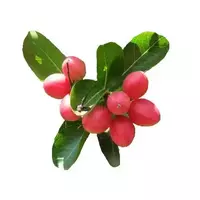Karanda

An exotic plant for our country called caranda (Carissa carandas or Carissa congesta) belongs to the Couter class family of the Dicotyledonous Division of the Angiosperms of the genus Carissa. In general, the caranda belongs to the category of fruit shrubs, the gifts of which in mature form are suitable for food.
The home country of the karanda is Asia, namely India, Malaysia, Myanmar and Sri Lanka. It is noteworthy that in these countries it is cultivated for the most part not for the sake of edible fruits, but for the purpose of creating living green barriers. But as a fruit plant, Karanda is grown in Thailand, Cambodia, South Vietnam, East Africa and the Philippines. On the American continent, the caranda can be found quite rarely.
Externally, the evergreen highly branched karanda shrub is as follows: its height varies from three to five meters, and numerous branches that are dotted with sharp spines (up to five centimeters) form a dense crown. The caranda leaves located on the branches in pairs are oval or elliptical in shape, their length can reach seven centimeters. Dark green caranda foliage is leathery glossy above and green on the underside.
The white tubular flowers of the caranda are characterized by a rich aroma. At the end of flowering, oblong or round fruits begin to form on the shrub, which, upon maturity, become from one and a half to two and a half centimeters in length. Mature caranda fruits are covered with a rather tough glossy smooth skin of crimson-red color. Moreover, gradually their color becomes dark purple, almost black. Inside the caranda fruit is a juicy red flesh, sweet and sour to taste, and sometimes even a little bitter. Often, the pulp of caranda fruits contains 2-8 small flat brown seeds.
In fresh form, it is customary to consume sweet varieties of karanda, while sour ones are often stewed with added sugar. In Asian countries, mature caranda fruits are used in the preparation of cakes, carries and puddings, and slightly undergrown are suitable for making jelly. Green sour caranda fruits are also suitable for culinary purposes - in India, for example, marinades are made from them.
For medicine, unripe caranda fruits are also important - due to their astringent properties, they are used as an effective natural remedy for gastrointestinal disorders. In addition, the decoction of caranda leaves has the same ability - it serves as a remedy for diarrhea, and the worming agent is the decoction of roots. Caranda roots contain salicylic acid and cardiac glycosides, which have the effect of lowering blood pressure in the lungs.
karanda 62 kKal
Energy value of caranda (Ratio of proteins, fats, carbohydrates - ju):
Proteins: 0.5 g (~ 2 kCal)
Fats: 1.3 g (~ 12 kCal)
Carbohydrates: 13.63 g (~ 55 kCal)
Energy ratio (bj | y): 3% | 19% | 88%
 Español
Español Français
Français Português
Português Русский
Русский 简体中文
简体中文 繁體中文
繁體中文 日本語
日本語 한국어
한국어 العربية
العربية Türkçe
Türkçe Қазақ
Қазақ Deutsch
Deutsch Italiano
Italiano Українська
Українська
